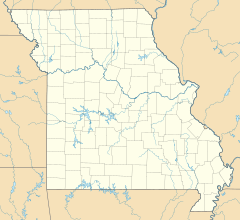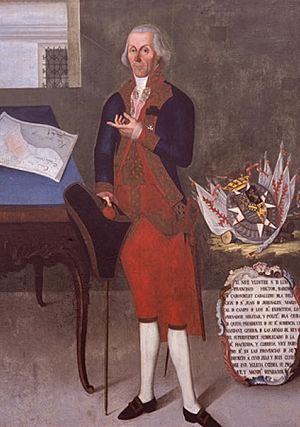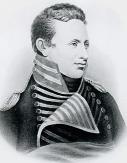Fort Carondelet facts for kids
Fort Carondelet was an important trading post built in 1795. It was located along the Osage River in what is now Vernon County, Missouri. The Chouteau family, who were famous fur traders, built this fort.
It served as a key spot for trading animal furs, especially with the Osage Nation. The Spanish government, which controlled the area called Spanish Louisiana at the time, also used the fort to keep good relationships with the Osage people. Fort Carondelet was sold in 1802 and then abandoned. By 1806, when explorer Zebulon Pike visited, the buildings were already falling apart.
Building a Trading Post
In the mid-1700s, the Osage Nation often traded furs with French and Spanish settlers. Two French brothers, Pierre Chouteau and Auguste Chouteau, were major traders from St. Louis. The Spanish government gave them permission to trade. By 1787, the Chouteau brothers had set up a temporary trading spot along the Osage River in western Missouri.
In 1791, Spanish Governor General Esteban Rodríguez Miró first suggested building a fort in western Missouri. He wanted to strengthen ties with Spanish allies among the Osage. Before the fort was built, Francisco Luis Héctor de Carondelet became the new Spanish governor.
Carondelet worried that the Osage might side with the French. So, in 1794, he met with six Osage chiefs. They agreed to let the fort be built in exchange for peace. Auguste Chouteau, the fur trader, offered to pay for the fort. It would replace his temporary trading post.
Chouteau described the fort as having two main parts. One part would be made of brick or stone. The other part would be made of strong logs. It was designed to be very solid and protect those inside. The fort would have thick doors and small openings for guns.
Carondelet agreed to Chouteau's plan. Chouteau received money each year to support soldiers at the fort. He also got a six-year special right to trade with the Osage. This meant no one else could trade with them there.
Life at Fort Carondelet
After it was built in 1795, Fort Carondelet became the westernmost outpost for the Chouteau family's trading business. It was used more as a trading post than a military fort. Pierre Chouteau managed the post and brought his sons to live near the Osage people. His sons learned a lot about the Osage culture and the lives of Native Americans.
The Osage Nation accepted Chouteau and his family. Other tribes, like the Miami, became jealous of the special treatment the Osage seemed to get.
The fort helped the Chouteau family expand their trade. While in charge, Pierre Chouteau and his son, Auguste Pierre Chouteau, extended their trade routes. By 1796, they were trading from Fort Carondelet to other Osage settlements near the Arkansas River.
Abandonment of the Fort
By 1800, other traders began to complain about the Chouteau family's special trading rights. They wanted the government to end the agreement. That same year, the new Spanish Governor General, Juan Manuel de Salcedo, gave the trading rights to one of the Chouteau's rivals, Manuel Lisa.
In 1802, Pierre Chouteau gave up trying to keep his special trading rights. He sold Fort Carondelet to Lisa. Lisa then removed the soldiers and abandoned the fort. When the Louisiana Purchase happened in 1804, Auguste Chouteau was asked by Spain to remove any remaining Spanish property from the fort.
After 1802, the fort's buildings quickly fell apart. By 1806, plants and trees had grown over them. Explorer Zebulon Pike visited the area during his expedition. He wrote in his journal that he passed the spot where Mr. Chouteau's fort used to be. Pike noted that "not a vestige of which was remaining," meaning there was no sign of it left. The only way to tell where it was, he said, was by the taller plants growing there.
After Pike's visit, few travelers mentioned the fort's location. The last report of the fort came from an 1874 Missouri travel guide. It described the top of Halley's Bluff as having "foundations of three furnaces" and "remains of works—both earth and stone." These were thought to be old fortifications from French explorers.
In the early 1900s, a Mormon group took possession of Halley's Bluff, where the fort once stood. This group, called the Church of Christ at Halley's Bluff, used the property as a compound from 1945 to 1979. Since the 1970s, another group called the Church of Israel has owned the site.




